Oscillatory Motion and Waves and Physics of Hearing.
131 Doppler Effect and Sonic Booms
Learning Objectives
- Define Doppler effect, Doppler shift, and sonic boom.
- Calculate the frequency of a sound heard by someone observing Doppler shift.
- Describe the sounds produced by objects moving faster than the speed of sound.
The familiar sound of a motorcycle zooming past—starting with a high-pitched whine that drops suddenly to a low-pitched roar—is a common example of the Doppler effect. The faster the motorcycle, and the closer it passes by the listener, the more noticeable the pitch change. We hear this same effect with passing race cars, trains, and airplanes. The Doppler effect is so common that it is often mimicked in play to represent movement.
The Doppler effect refers to the change in the frequency of a sound as perceived by an observer due to motion of either the sound source or the observer. When the source or observer is moving, the observed frequency differs from the emitted frequency. This change is called a Doppler shift. Though commonly associated with moving sources, the effect is also apparent when a stationary sound source is heard by a moving observer. For instance, when riding a train past a ringing bell, the pitch of the bell appears higher as you approach and lower as you move away.
This phenomenon was first studied by Austrian physicist Christian Johann Doppler (1803–1853), who conducted experiments involving musicians performing on moving train cars and on the ground. Observers measured changes in pitch depending on their location relative to the motion of the sound source.
Figures 131.1, 131.2, and 131.3 illustrate how sound waves behave differently for stationary versus moving sources and observers. In Figure 131.1, the source, observers, and air are all stationary, so the sound waves are evenly spaced in all directions, and both observers hear the same frequency.
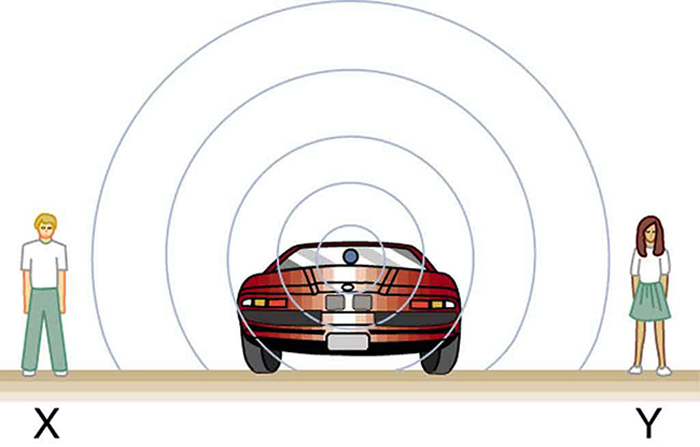
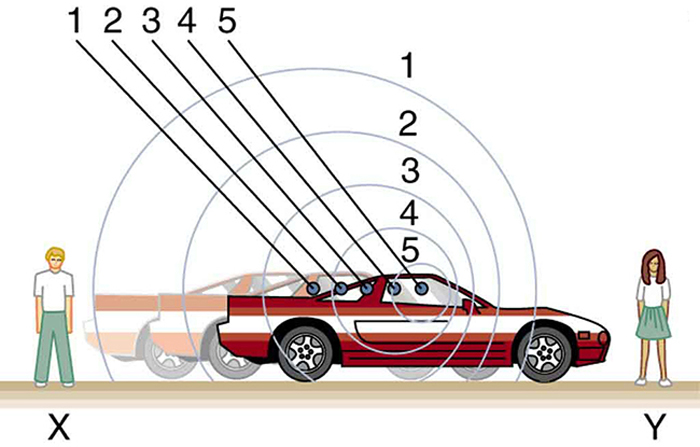

In Figure 131.2, the source is moving to the right. Each compression of air is emitted from a point that keeps changing position, resulting in compressed waves ahead of the source (shorter wavelength and higher frequency) and spread-out waves behind it (longer wavelength and lower frequency). As a result, the observer in front of the moving source hears a higher-pitched sound, while the one behind hears a lower pitch.
Figure 131.3 shows the effect of motion by the observer rather than the source. The observer moving toward a stationary source encounters wavefronts more frequently, hearing a higher frequency. In contrast, an observer moving away encounters fewer wavefronts per second and hears a lower pitch.
Since the speed of sound [latex]v_w[/latex] is constant in a given medium, a change in perceived wavelength implies a change in perceived frequency. Thus, motion toward a source compresses the wavelength and increases the observed frequency. Motion away stretches the wavelength and lowers the observed frequency. The faster the relative motion, the larger the frequency shift.
The Doppler Effect
The Doppler effect applies to all types of waves, including sound, light, and water waves. It is widely used in applications ranging from weather radar and medical imaging to astronomy. For instance, Doppler ultrasound is used to measure the speed of blood flow in arteries, while redshifts in light from distant galaxies are used to study the expansion of the universe.
For a stationary observer and a moving source, the observed frequency [latex]f_{\text{obs}}[/latex] is given by:
Here, [latex]f_s[/latex] is the frequency emitted by the source, [latex]v_s[/latex] is the speed of the source, and [latex]v_w[/latex] is the speed of sound. Use the minus sign when the source moves toward the observer (increasing frequency), and the plus sign when it moves away (decreasing frequency).
For a stationary source and a moving observer, the observed frequency is:
In this case, [latex]v_{\text{obs}}[/latex] is the speed of the observer. Use the plus sign if the observer moves toward the source (hearing a higher frequency), and the minus sign if moving away (hearing a lower frequency).
Example 131.1: Calculate Doppler Shift: A Train Horn
Suppose a train that has a 150-Hz horn is moving at 35.0 m/s in still air on a day when the speed of sound is 340 m/s.
- What frequencies are observed by a stationary person at the side of the tracks as the train approaches and after it passes?
- What frequency is observed by the train’s engineer traveling on the train?
Strategy
To find the observed frequency in (a), [latex]{f}_{\text{obs}}={f}_{s}\left(\frac{{v}_{w}}{{v}_{w}±{v}_{s}}\right),[/latex] must be used because the source is moving. The minus sign is used for the approaching train, and the plus sign for the receding train. In (b), there are two Doppler shiftss—one for a moving source and the other for a moving observer.
Solution for (a)
- Enter known values into [latex]{f}_{\text{obs}}={f}_{s}\left(\frac{{v}_{w}}{{v}_{w}\phantom{\rule{0.25em}{0ex}}–\phantom{\rule{0.25em}{0ex}}{v}_{s}}\right).[/latex]
[latex]{f}_{\text{obs}}={f}_{s}\left(\frac{{v}_{w}}{{v}_{w}-{v}_{s}}\right)=\left(\text{150 Hz}\right)\left(\frac{\text{340 m/s}}{\text{340 m/s – 35.0 m/s}}\right)[/latex]
- Calculate the frequency observed by a stationary person as the train approaches.
[latex]{f}_{obs}=\left(\text{150 Hz}\right)\left(\text{1.11}\right)=\text{167 Hz}[/latex]
- Use the same equation with the plus sign to find the frequency heard by a stationary person as the train recedes.
[latex]{f}_{\text{obs}}={f}_{s}\left(\frac{{v}_{w}}{{v}_{w}+{v}_{s}}\right)=\left(\text{150 Hz}\right)\left(\frac{\text{340 m/s}}{\text{340 m/s}+\text{35.0 m/s}}\right)[/latex]
- Calculate the second frequency.
[latex]{f}_{obs}=\left(\text{150 Hz}\right)\left(0.907\right)=\text{136 Hz}[/latex]
Discussion on (a)
The numbers calculated are valid when the train is far enough away that the motion is nearly along the line joining train and observer. In both cases, the shift is significant and easily noticed. Note that the shift is 17.0 Hz for motion toward and 14.0 Hz for motion away. The shifts are not symmetric.
Solution for (b)
- Identify knowns:
- • It seems reasonable that the engineer would receive the same frequency as emitted by the horn, because the relative velocity between them is zero.
- • Relative to the medium (air), the speeds are [latex]{v}_{s}={v}_{\text{obs}}=35.0 m/s.[/latex]
- • The first Doppler shift is for the moving observer; the second is for the moving source.
- Use the following equation:
[latex]{f}_{\text{obs}}=\left[{f}_{s}\left(\frac{{v}_{w}±{v}_{\text{obs}}}{{v}_{w}}\right)\right]\left(\frac{{v}_{w}}{{v}_{w}±{v}_{s}}\right).[/latex]
The quantity in the square brackets is the Doppler-shifted frequency due to a moving observer. The factor on the right is the effect of the moving source.
- Because the train engineer is moving in the direction toward the horn, we must use the plus sign for [latex]{v}_{obs};[/latex] however, because the horn is also moving in the direction away from the engineer, we also use the plus sign for [latex]{v}_{s}[/latex]. But the train is carrying both the engineer and the horn at the same velocity, so [latex]{v}_{s}={v}_{obs}[/latex]. As a result, everything but [latex]{f}_{s}[/latex] cancels, yielding [latex]{f}_{\text{obs}}\text{=}{f}_{s}.[/latex]
Discussion for (b)
We may expect that there is no change in frequency when source and observer move together because it fits your experience. For example, there is no Doppler shift in the frequency of conversations between driver and passenger on a motorcycle. People talking when a wind moves the air between them also observe no Doppler shift in their conversation. The crucial point is that source and observer are not moving relative to each other.
Sonic Booms to Bow Wakes
What happens when a source of sound, like a jet aircraft, moves toward or even faster than the speed of sound? This question has implications not just for sound but for all types of waves.
Suppose a jet plane is flying nearly directly toward a listener while emitting sound at frequency [latex]f_s[/latex]. As the plane’s speed [latex]v_s[/latex] increases, the Doppler shift increases, and the observed frequency [latex]f_{\text{obs}}[/latex] becomes greater. The formula for the Doppler effect is:
As the speed of the source [latex]v_s[/latex] approaches the speed of sound [latex]v_w[/latex], the denominator approaches zero, and the observed frequency theoretically approaches infinity. Physically, this means that each successive sound wave is emitted from the same point in space as the previous one, stacking up and forming a large pressure front. When the source breaks the sound barrier, this pressure front becomes a shock wave, and the listener experiences a sonic boom. (See Figure 131.4.)
In three dimensions, the sound waves form a cone behind the moving object. Along the surface of this cone, constructive interference occurs, forming a sharp and intense sound wave—the sonic boom. Inside the cone, interference is mostly destructive, resulting in quieter regions. An aircraft typically produces two sonic booms: one from the nose and one from the tail. These can be heard as two distinct booms by an observer on the ground, separated by the time it takes the aircraft to pass overhead. (See Figure 131.5.)
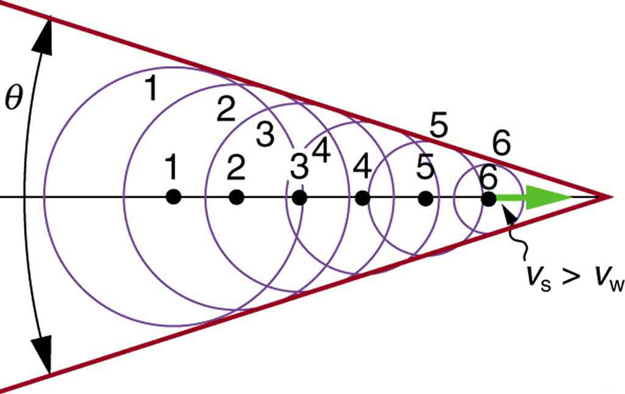
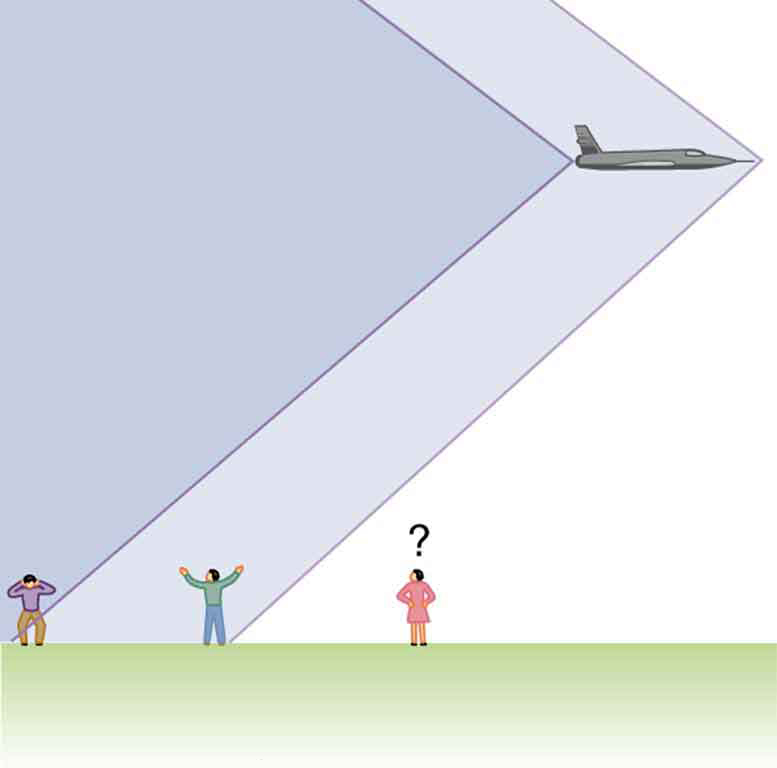
Sonic booms are a specific case of a broader wave phenomenon known as bow wakes. A bow wake is created when any wave source travels faster than the wave speed in the medium. A familiar example is the V-shaped wake behind a duck swimming through water faster than wave ripples can spread. (See Figure 131.6.)
Bow wakes aren’t limited to sound or water. In particle physics, a subatomic particle moving faster than the speed of light in a medium (such as water) creates a visual analog to the sonic boom, called Cerenkov radiation. This radiation appears as a cone of blue light, often observed in nuclear reactors. (See Figure 131.7.)

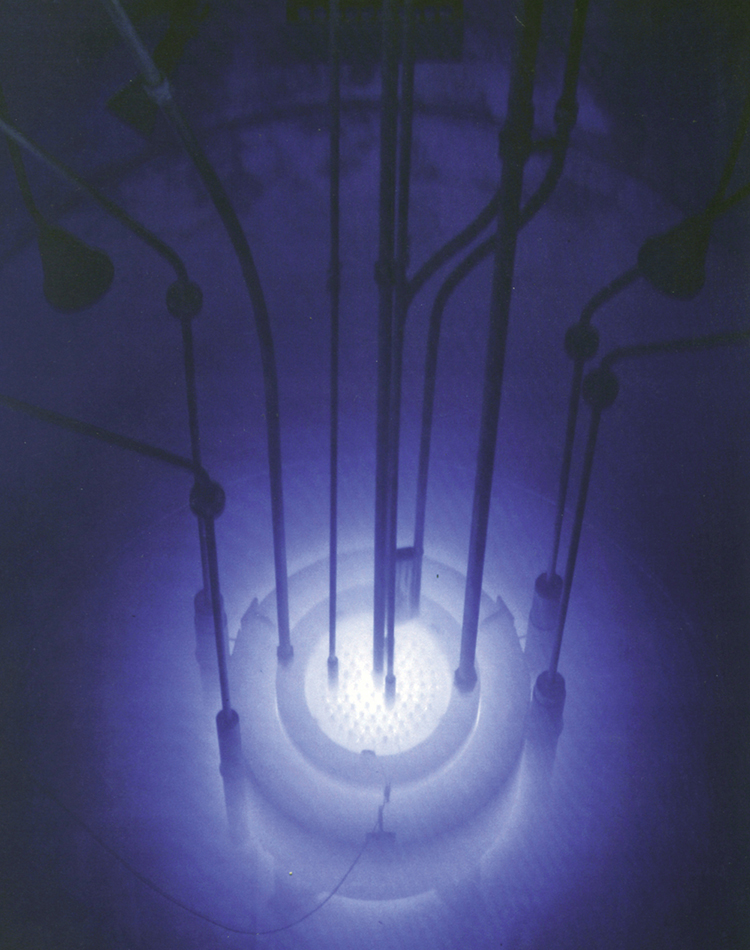
Both Doppler shifts and sonic booms are important phenomena with a wide range of practical applications. For example, the Doppler shift is used in:
- Medical imaging, such as Doppler ultrasound to measure blood flow velocity
- Law enforcement radar to determine vehicle speeds
- Meteorology, to track the velocity of weather systems using Doppler radar
- Astronomy, to determine the speed and direction of distant galaxies based on the red shift of light, helping estimate the age of the universe
Check Your Understanding
Why did scientist Christian Doppler observe musicians both on a moving train and also from a stationary point not on the train?
Doppler needed to compare the perception of sound when the observer is stationary and the source moves, and vice versa. This helped him understand how relative motion affects observed frequency.
Describe a situation in your life when you might rely on the Doppler shift to help you either while driving a car or walking near traffic.
If I hear the pitch of a siren rising as an ambulance approaches while driving, I know to prepare to pull over. The Doppler shift helps me tell whether the vehicle is approaching or has passed.
Section Summary
- The Doppler effect is a change in observed sound frequency due to motion of the source or observer.
- The change in frequency is called the Doppler shift.
- A sonic boom is a shock wave formed by constructive interference when a source travels faster than sound.
- Sonic booms are a specific type of bow wake, which occurs when any wave source exceeds the wave speed in the medium.
- For a stationary observer and moving source:
[latex]f_{\text{obs}} = f_s \left( \frac{v_w}{v_w \pm v_s} \right)[/latex]
- For a stationary source and moving observer:
[latex]f_{\text{obs}} = f_s \left( \frac{v_w \pm v_{\text{obs}}}{v_w} \right)[/latex]
Conceptual Questions
- Is the Doppler shift real or just a sensory illusion?
- Due to efficiency considerations related to its bow wake, the supersonic transport aircraft must maintain a cruising speed that is a constant ratio to the speed of sound (a constant Mach number). If the aircraft flies from warm air into colder air, should it increase or decrease its speed? Explain your answer.
- When you hear a sonic boom, you often cannot see the plane that made it. Why is that?
Problems & Exercises
- (a) What frequency is received by a person watching an oncoming ambulance moving at 110 km/h and emitting a steady 800-Hz sound from its siren? The speed of sound on this day is 345 m/s. (b) What frequency does she receive after the ambulance has passed?
- (a) At an air show a jet flies directly toward the stands at a speed of 1200 km/h, emitting a frequency of 3500 Hz, on a day when the speed of sound is 342 m/s. What frequency is received by the observers? (b) What frequency do they receive as the plane flies directly away from them?
- What frequency is received by a mouse just before being dispatched by a hawk flying at it at 25.0 m/s and emitting a screech of frequency 3500 Hz? Take the speed of sound to be 331 m/s.
- A spectator at a parade receives an 888-Hz tone from an oncoming trumpeter who is playing an 880-Hz note. At what speed is the musician approaching if the speed of sound is 338 m/s?
- A commuter train blows its 200-Hz horn as it approaches a crossing. The speed of sound is 335 m/s. (a) An observer waiting at the crossing receives a frequency of 208 Hz. What is the speed of the train? (b) What frequency does the observer receive as the train moves away?
- Can you perceive the shift in frequency produced when you pull a tuning fork toward you at 10.0 m/s on a day when the speed of sound is 344 m/s? To answer this question, calculate the factor by which the frequency shifts and see if it is greater than 0.300%.
- Two eagles fly directly toward one another, the first at 15.0 m/s and the second at 20.0 m/s. Both screech, the first one emitting a frequency of 3200 Hz and the second one emitting a frequency of 3800 Hz. What frequencies do they receive if the speed of sound is 330 m/s?
- What is the minimum speed at which a source must travel toward you for you to be able to hear that its frequency is Doppler shifted? That is, what speed produces a shift of 0.300% on a day when the speed of sound is 331 m/s?
Glossary
- Doppler effect
- an alteration in the observed frequency of a sound due to motion of either the source or the observer
- Doppler shift
- the actual change in frequency due to relative motion of source and observer
- sonic boom
- a constructive interference of sound created by an object moving faster than sound
- bow wake
- V-shaped disturbance created when the wave source moves faster than the wave propagation speed
an alteration in the observed frequency of a sound due to motion of either the source or the observer
the actual change in frequency due to relative motion of source and observer
V-shaped disturbance created when the wave source moves faster than the wave propagation speed
a constructive interference of sound created by an object moving faster than sound

